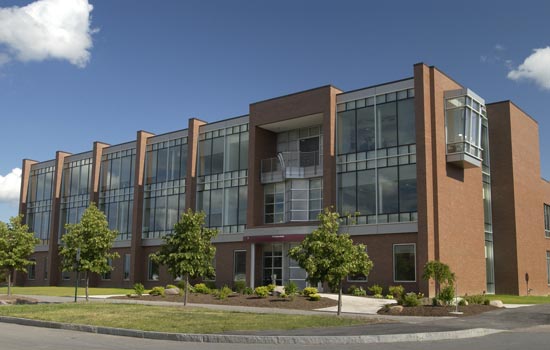RIT gathering to explore remote sensing, regional economy
A. Sue Weisler
RIT\'s IT Collaboratory building
Evolving national and international concerns related to emergency preparedness, particularly as they relate to homeland security, are driving the growing demand for remote-sensing technology. How can regional resources and RIT’s expertise in that area help expand economic development across upstate New York? That question serves as the foundation for the IT Collaboratory 2007 Research Symposium.
The event will be held at RIT on April 17 and is intended to create and support research interaction among the IT Collaboratory’s university partners, along with industry and government research sponsors. This year’s symposium will focus exclusively on remote sensing. Issues related to the economic and policy side of the symposium will be addressed in presentations by Michael Relyea, executive director of the New York State Office of Science, Technology and Academic Research (NYSTAR); and Michael Balboni, deputy secretary to the governor for public safety. “The role of the keynote speakers is to address the broader concept of how these technologies are going to improve the area’s business opportunities and economic development,” states Mike Dwyer, director of RIT’s Research Relations Office.
Speakers from the technology side of the event include Joseph Westbay, vice president of engineering for the Space Systems Division of ITT Corp.; Charles Mondello, senior vice president of corporate development at Pictometry International; and Earnest Reith, director of the InnoVision Full Spectrum Office at the National Geospatial-Intelligence Agency. Both ITT and Pictometry employ a growing number of people locally in the manufacture of remote-sensing technology. Dwyer says that by combining RIT’s leadership in developing this technology, the potential to exploit remote sensing for the benefit of regional economic development is significant.
The symposium also features breakout sessions that explore research results in a variety of technical topics. “Each session is charged with talking about technology challenges and opportunities—how we can work together to create solutions to problems that these companies and agencies are facing,” explains Dwyer. Implications for emergency preparedness are among the key areas of focus. Vincent Amuso, RIT associate professor of electrical engineering, leads one session on how sensors aid surveillance in dynamically changing environments. Another presentation, led by Harvey Rhody, director of RIT’s Laboratory for Imaging Algorithms and Systems, explores systems to deliver critical information to the responder community.
The interaction between researchers and sponsors of the symposium highlights the goal of NYSTAR to increase economic success in New York using collaborative university-based research as the catalyst. The agenda is designed to facilitate connections among faculty, scientists and research sponsors while offering unique opportunities for all participants to discuss new ideas in their fields. The IT Collaboratory is an RIT-led research collaboration with the University at Buffalo and Alfred University. Started in 2001 with a grant from NYSTAR, the IT Collaboratory targets the creation of key technologies, knowledge, and capabilities to design and integrate next-generation information technology systems. In addition to remote sensing, the center focuses on research related to microsystems, photonics and nanomaterials.









